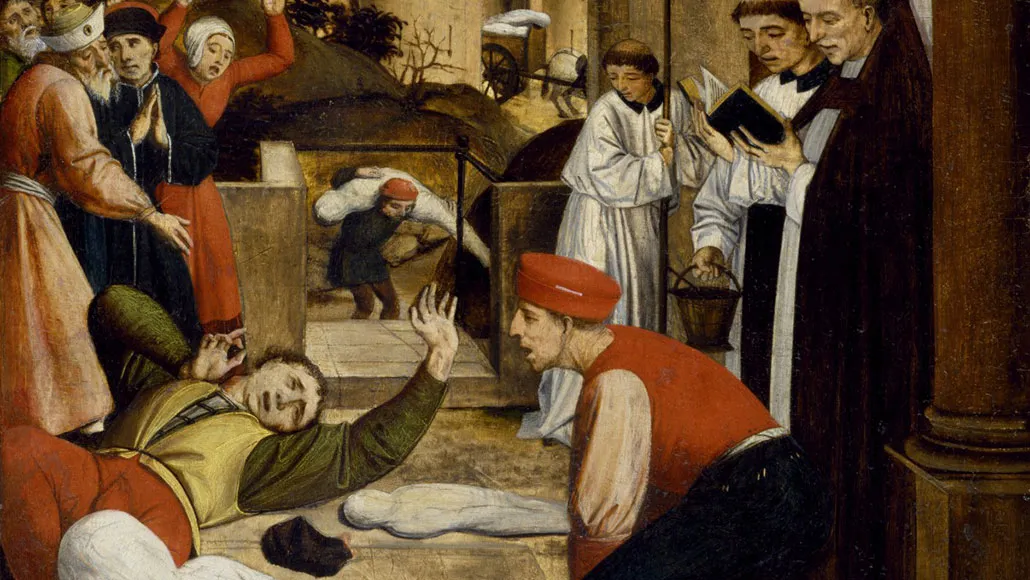An ancient outbreak of bubonic plague may have been exaggerated
Archaeological evidence suggests a sixth century epidemic didn’t radically change European history

A sixth century Eurasian plague, depicted in this painting as suddenly striking the Italian man on the left, was nowhere near as deadly and politically destabilizing as many scholars have assumed, an analysis indicates.
Josse Lieferinxe/Walters Art Museum (CC0)
An ancient bubonic plague outbreak often characterized as a mass killer that felled Eurasian civilizations was actually pretty tame, researchers say.
Known as the Justinianic plague, the outbreak likely didn’t cause enough deaths to trigger major events such as the eastern Roman Empire’s decline, Islam’s rise and the emergence of modern Europe, say environmental historian Lee Mordechai and his colleagues.
Many scholars have argued that the Justinianic plague caused tens of millions of deaths starting in the sixth century and reduced European and Middle Eastern populations by 25 to 60 percent. Economies crumbled as a result, devastating what was left of the Roman Empire and ushering in a period of cultural stagnation, from this perspective.
But several new lines of archaeological evidence related to ancient population and economic changes challenge that scenario, Mordechai and his team report December 2 in the Proceedings of the National Academy of Sciences.
“Support for the claim that the Justinianic plague was a watershed event in the ancient world is just not there,” says study coauthor Merle Eisenberg, an environmental historian at the University of Maryland’s National Socio-Environmental Synthesis Center in Annapolis. Yet a scenario of the plague outbreak wiping out populations and reshaping societies appears in many textbooks on ancient history, he says.
The Justinianic outbreak, caused by the plague bacterium Yersinia pestis, occurred several centuries before the more widely known Black Death plague, which killed tens of millions of people in the 14th century (SN: 1/17/16). An initial outbreak began during the reign of Emperor Justinian, who ruled the eastern part of the Roman Empire after the fall of Rome, and ran from around 541 to 544. Intermittent plague reoccurrences lasted until around 750, and stretched around the Mediterranean and into Europe and the Middle East.
Researchers in different disciplines have often wrongly assumed that evidence from archaeology, genetics, ancient texts and other sources all indicate that the Justinianic plague wreaked social havoc, contends geographer Neil Roberts of the University of Plymouth in England. Mordechai’s team has assessed evidence from across disciplines to reach a contrasting but plausible conclusion, says Roberts, who did not participate in the study.
In one new finding that points to the Justinianic plague having only a modest impact, land use and cereal cultivation remained largely unchanged during the sixth century in several eastern Mediterranean regions often said to have been shattered by plague. Based on ancient pollen data collected by other investigators, Mordechai, also of the National Socio-Environmental Synthesis Center, and his group found no signs of people abandoning farmland in those areas, including agricultural sites near Roman trade routes and cities such as Constantinople, now Istanbul, where plague could have spread quickly.
Neither did burials of five or more deceased individuals in the same grave increase in sixth century Europe, the researchers say. In particular, they emphasize, evidence from 8,207 ancient graves across what’s now England, Scotland and Wales suggests that multiple interments increased slowly starting in the 300s, with no unusual jumps during the time of the Justinianic plague. Mass burials represent another possible sign of a particularly deadly plague outbreak, but in some regions could reflect a cultural practice aimed at keeping deceased members of the same families or social groups together.
Early historical texts and stone inscriptions from Europe and the eastern Mediterranean contain few plague references, the investigators also found. And other written sources indicate that official Roman legislation did not decline after the 541 outbreak, as would be expected in a social crisis. Archaeological finds from two Mediterranean sites suggest that coin circulation also remained stable during the 540s. Roman texts point to similar stability at that time for gold values.
What’s more, some researchers have assumed that the Justinianic plague killed many Egyptians. But official papyruses dating to years from 520 to 570 don’t refer to a plague outbreak and contain no evidence of population declines, land abandonment or drops in tax revenue, Mordechai’s team found.
Y. pestis DNA, now isolated from about 45 Europeans dating to around the time of the sixth century outbreak, doesn’t by itself mean that the plague killed huge numbers of people, the researchers contend. That’s because the Y. pestis associated with the Justinianic plague was not directly ancestral to later, especially deadly Y. pestis strains known to have caused the Black Death (SN: 10/14/11), the scientists say.
Although the Justinianic plague probably struck some densely populated areas, “the idea that it was a blanket catastrophe affecting all parts of the Mediterranean, Middle East and central and western European worlds needs to be rethought,” says Princeton University’s John Haldon, a historian of ancient Europe and the Mediterranean who did not contribute to the new research.
Even the Black Death didn’t topple political systems, Haldon says. For instance, the Hundred Years’ War, waged between the kingdoms of England and France from 1337 to 1453, barely wavered as the Black Death spread. There’s no reason to expect that an apparently less deadly, sixth century plague capsized a big chunk of the Roman Empire or any other ancient state, he contends.







